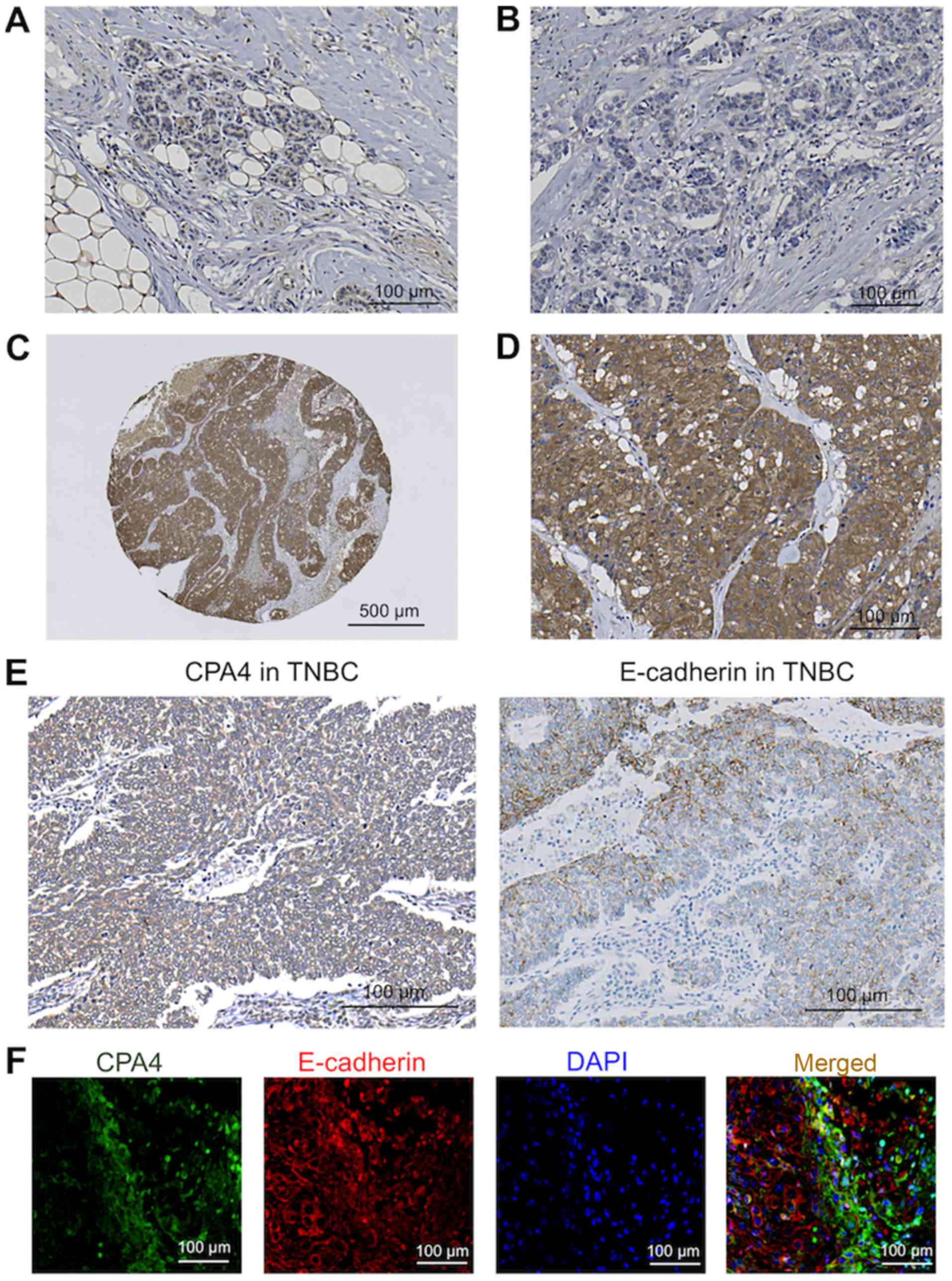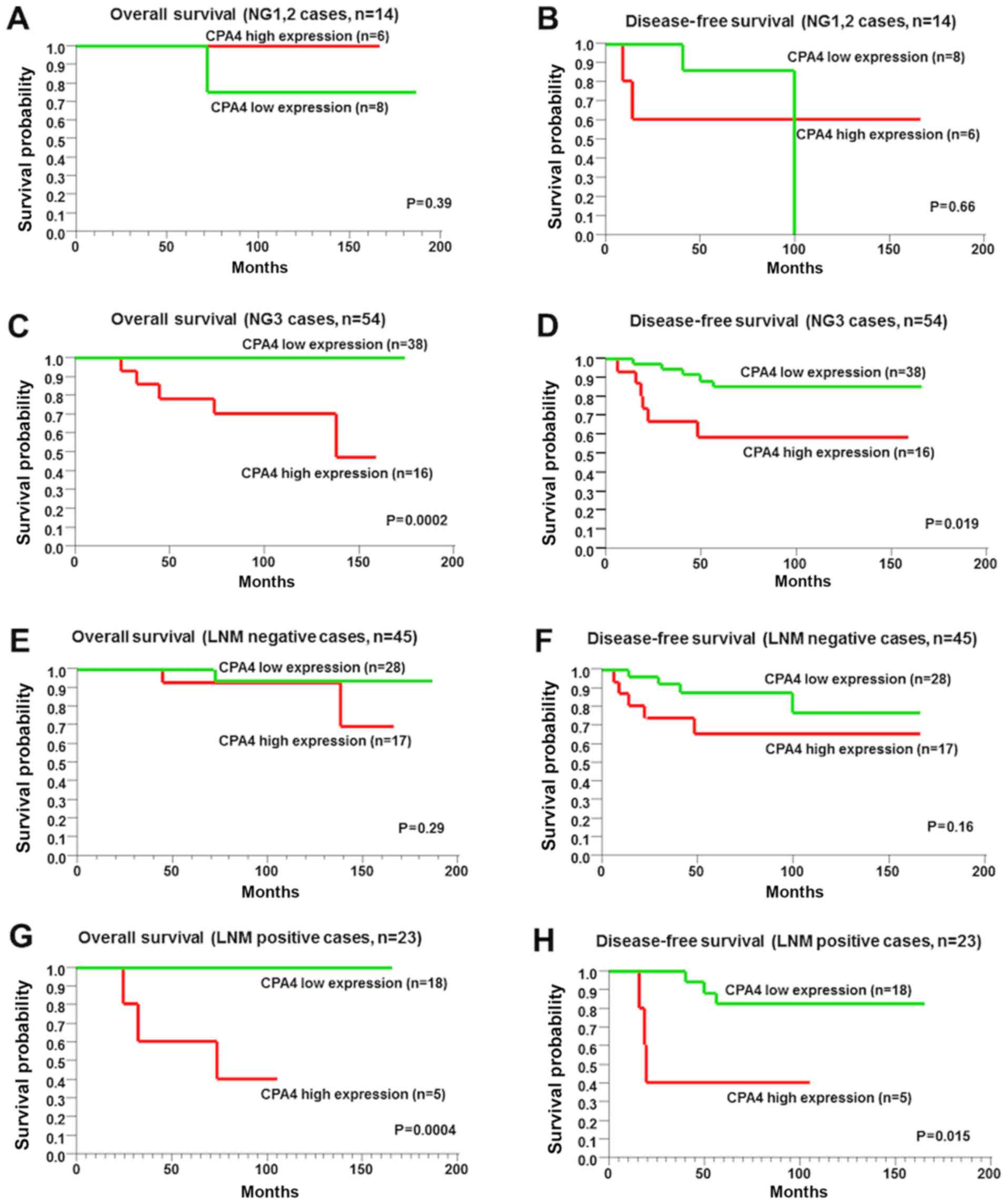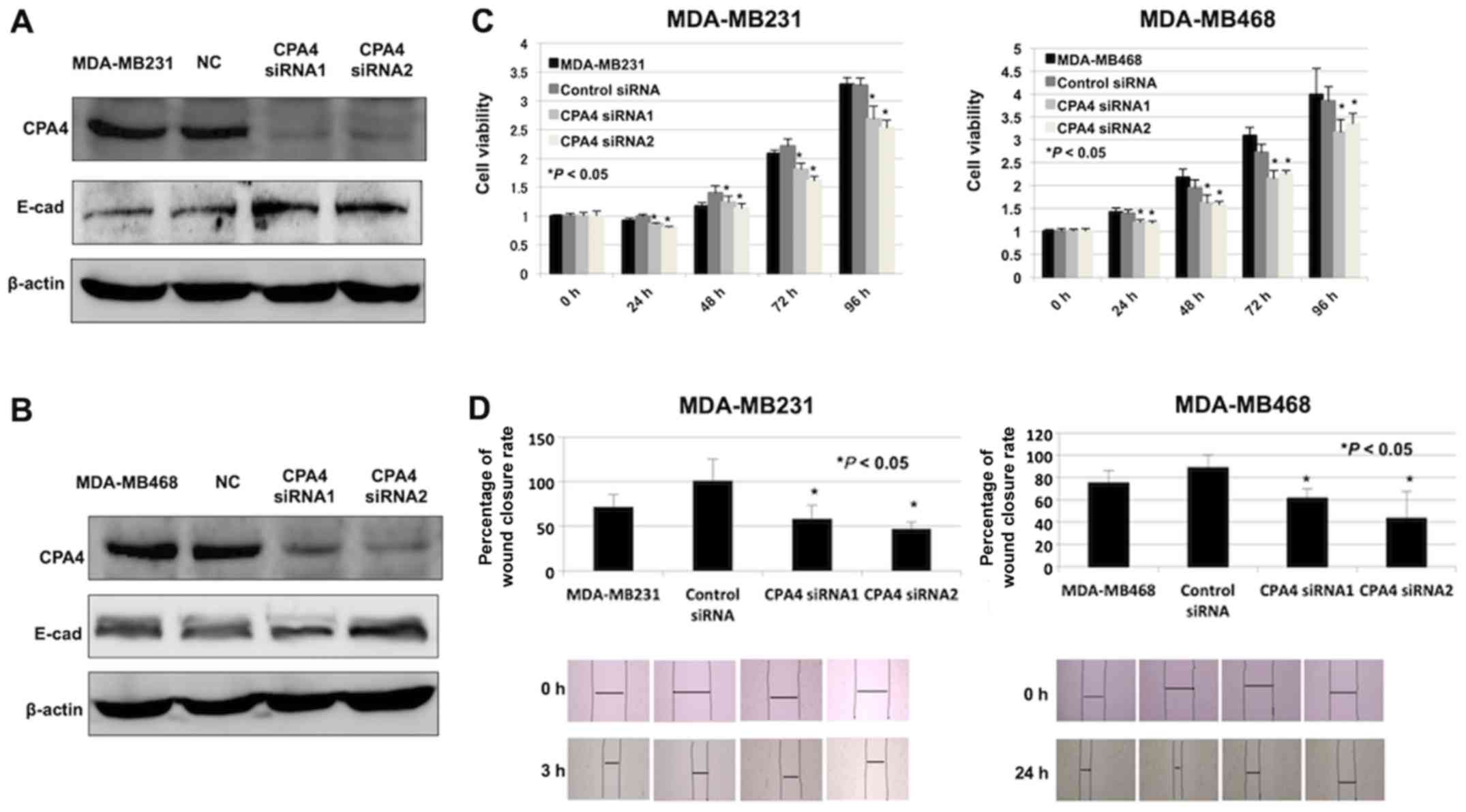|
1
|
Perou CM, Sørlie T, Eisen MB, van de Rijn
M, Jeffrey SS, Rees CA, Pollack JR, Ross DT, Johnsen H, Akslen LA,
et al: Molecular portraits of human breast tumours. Nature.
406:747–752. 2000. View
Article : Google Scholar : PubMed/NCBI
|
|
2
|
Carey LA, Perou CM, Livasy CA, Dressler
LG, Cowan D, Conway K, Karaca G, Troester MA, Tse CK, Edmiston S,
et al: Race, breast cancer subtypes, and survival in the Carolina
Breast Cancer Study. JAMA. 295:2492–2502. 2006. View Article : Google Scholar : PubMed/NCBI
|
|
3
|
Goldhirsch A, Winer EP, Coates AS, Gelber
RD, Piccart-Gebhart M, Thürlimann B and Senn HJ; Panel members:
Personalizing the treatment of women with early breast cancer:
highlights of the St Gallen International Expert Consensus on the
Primary Therapy of Early Breast Cancer 2013. Ann Oncol.
24:2206–2223. 2013. View Article : Google Scholar : PubMed/NCBI
|
|
4
|
Dent R, Trudeau M, Pritchard KI, Hanna WM,
Kahn HK, Sawka CA, Lickley LA, Rawlinson E, Sun P and Narod SA:
Triple-negative breast cancer: Clinical features and patterns of
recurrence. Clin Cancer Res. 13:4429–4434. 2007. View Article : Google Scholar : PubMed/NCBI
|
|
5
|
Giatromanolaki A, Sivridis E, Fiska A and
Koukourakis MI: The CD44+/CD24- phenotype
relates to 'triple-negative' state and unfavorable prognosis in
breast cancer patients. Med Oncol. 28:745–752. 2011. View Article : Google Scholar
|
|
6
|
Idowu MO, Kmieciak M, Dumur C, Burton RS,
Grimes MM, Powers CN and Manjili MH: CD44(+)/CD24(-/low) cancer
stem/progenitor cells are more abundant in triple-negative invasive
breast carcinoma phenotype and are associated with poor outcome.
Hum Pathol. 43:364–373. 2012. View Article : Google Scholar
|
|
7
|
Mani SA, Guo W, Liao MJ, Eaton EN, Ayyanan
A, Zhou AY, Brooks M, Reinhard F, Zhang CC, Shipitsin M, et al: The
epithelial-mesenchymal transition generates cells with properties
of stem cells. Cell. 133:704–715. 2008. View Article : Google Scholar : PubMed/NCBI
|
|
8
|
Tanco S, Zhang X, Morano C, Avilés FX,
Lorenzo J and Fricker LD: Characterization of the substrate
specificity of human carboxypeptidase A4 and implications for a
role in extracellular peptide processing. J Biol Chem.
285:18385–18396. 2010. View Article : Google Scholar : PubMed/NCBI
|
|
9
|
Sun L, Cao J, Guo C, Burnett J, Yang Z,
Ran Y and Sun D: Associations of carboxypeptidase 4 with ALDH1A1
expression and their prognostic value in esophageal squamous cell
carcinoma. Dis Esophagus. 30:1–5. 2017. View Article : Google Scholar
|
|
10
|
Sun L, Guo C, Burnett J, Pan J, Yang Z,
Ran Y and Sun D: Association between expression of carboxypeptidase
4 and stem cell markers and their clinical significance in liver
cancer development. J Cancer. 8:111–116. 2017. View Article : Google Scholar : PubMed/NCBI
|
|
11
|
Sun L, Guo C, Yuan H, Burnett J, Pan J,
Yang Z, Ran Y, Myers I and Sun D: Overexpression of
carboxypeptidase A4 (CPA4) is associated with poor prognosis in
patients with gastric cancer. Am J Transl Res. 8:5071–5075.
2016.PubMed/NCBI
|
|
12
|
Sun L, Guo C, Burnett J, Yang Z, Ran Y and
Sun D: Serum carboxypeptidaseA4 levels predict liver metastasis in
colorectal carcinoma. Oncotarget. 7:78688–78697. 2016. View Article : Google Scholar : PubMed/NCBI
|
|
13
|
Sun L, Wang Y, Yuan H, Burnett J, Pan J,
Yang Z, Ran Y, Myers I and Sun D: CPA4 is a novel diagnostic and
prognostic marker for human non-small-cell lung cancer. J Cancer.
7:1197–1204. 2016. View Article : Google Scholar : PubMed/NCBI
|
|
14
|
Sun L, Burnett J, Guo C, Xie Y, Pan J,
Yang Z, Ran Y and Sun D: CPA4 is a promising diagnostic serum
biomarker for pancreatic cancer. Am J Cancer Res. 6:91–96.
2015.
|
|
15
|
Tan AA, Phang WM, Gopinath SC, Hashim OH,
Kiew LV and Chen Y: Revealing Glycoproteins in the Secretome of
MCF-7 Human Breast Cancer Cells. BioMed Res Int. 2015:4532892015.
View Article : Google Scholar : PubMed/NCBI
|
|
16
|
Finn RS, Dering J, Conklin D, Kalous O,
Cohen DJ, Desai AJ, Ginther C, Atefi M, Chen I, Fowst C, et al: PD
0332991, a selective cyclin D kinase 4/6 inhibitor, preferentially
inhibits proliferation of luminal estrogen receptor-positive human
breast cancer cell lines in vitro. Breast Cancer Res. 11:R772009.
View Article : Google Scholar : PubMed/NCBI
|
|
17
|
Sun J, Nishiyama T, Shimizu K and Kadota
K: TCC: An R package for comparing tag count data with robust
normalization strategies. BMC Bioinformatics. 14:2192013.
View Article : Google Scholar : PubMed/NCBI
|
|
18
|
Sobin LH, Gospodarowicz MK and Wittekind
C; International Union against Cancer: TNM Classification of
Malignant Tumours. Wiley-Blackwell; West Sussex, UK; Hoboken, NJ:
2010
|
|
19
|
Handa T, Katayama A, Yokobori T, Yamane A,
Horiguchi J, Kawabata-Iwakawa R, Rokudai S, Bao P, Gombodorj N,
Altan B, et al: Caspase14 expression is associated with triple
negative phenotypes and cancer stem cell marker expression in
breast cancer patients. J Surg Oncol. 116:706–715. 2017. View Article : Google Scholar : PubMed/NCBI
|
|
20
|
Wolff AC, Hammond ME, Hicks DG, Dowsett M,
McShane LM, Allison KH, Allred DC, Bartlett JM, Bilous M,
Fitzgibbons P, et al American Society of Clinical Oncology; College
of American Pathologists: Recommendations for human epidermal
growth factor receptor 2 testing in breast cancer: American Society
of Clinical Oncology/College of American Pathologists clinical
practice guideline update. J Clin Oncol. 31:3997–4013. 2013.
View Article : Google Scholar : PubMed/NCBI
|
|
21
|
Dowsett M, Nielsen TO, A'Hern R, Bartlett
J, Coombes RC, Cuzick J, Ellis M, Henry NL, Hugh JC, Lively T, et
al International Ki-67 in Breast Cancer Working Group: Assessment
of Ki67 in breast cancer: Recommendations from the International
Ki67 in Breast Cancer working group. J Natl Cancer Inst.
103:1656–1664. 2011. View Article : Google Scholar : PubMed/NCBI
|
|
22
|
Obayashi S, Horiguchi J, Higuchi T,
Katayama A, Handa T, Altan B, Bai T, Bao P, Bao H, Yokobori T, et
al: Stathmin1 expression is associated with aggressive phenotypes
and cancer stem cell marker expression in breast cancer patients.
Int J Oncol. 51:781–790. 2017. View Article : Google Scholar : PubMed/NCBI
|
|
23
|
Senol S, Sayar I, Ceyran AB, Ibiloglu I,
Akalin I, Firat U, Kosemetin D, Engin Zerk P and Aydin A: Stromal
clues in endometrial carcinoma: Loss of expression of β-catenin,
epithelial-mesenchymal transition regulators, and
estrogen-Progesterone Receptor. Int J Gynecol Pathol. 35:238–248.
2016. View Article : Google Scholar :
|
|
24
|
Lehmann BD, Bauer JA, Chen X, Sanders ME,
Chakravarthy AB, Shyr Y and Pietenpol JA: Identification of human
triple-negative breast cancer subtypes and preclinical models for
selection of targeted therapies. J Clin Invest. 121:2750–2767.
2011. View
Article : Google Scholar : PubMed/NCBI
|
|
25
|
Ye Y, Liu P, Wang Y, Li H, Wei F, Cheng Y,
Han L and Yu J: Neurotensin, a novel messenger to cross-link
inflammation and tumor invasion via epithelial-mesenchymal
transition pathway. Int Rev Immunol. 35:340–350. 2016.PubMed/NCBI
|
|
26
|
Johnston SR: New strategies in estrogen
receptor-positive breast cancer. Clin Cancer Res. 16:1979–1987.
2010. View Article : Google Scholar : PubMed/NCBI
|
|
27
|
Alonso del Rivero M, Reytor ML, Trejo SA,
Chávez MA, Avilés FX and Reverter D: A noncanonical mechanism of
carboxypeptidase inhibition revealed by the crystal structure of
the Tri-Kunitz SmCI in complex with human CPA4. Structure.
21:1118–1126. 2013. View Article : Google Scholar : PubMed/NCBI
|
|
28
|
Alonso-del-Rivero M, Trejo SA, Reytor ML,
Rodriguez-de-la-Vega M, Delfin J, Diaz J, González-González Y,
Canals F, Chavez MA and Aviles FX: Tri-domain bifunctional
inhibitor of metallocarboxypeptidases A and serine proteases
isolated from marine annelid Sabellastarte magnifica. J Biol Chem.
287:15427–15438. 2012. View Article : Google Scholar : PubMed/NCBI
|
|
29
|
Al-Awadhi FH, Salvador LA, Law BK, Paul VJ
and Luesch H: Kempopeptin C, a novel marine-derived serine protease
inhibitor targeting invasive breast cancer. Mar Drugs. 15:152017.
View Article : Google Scholar
|




















